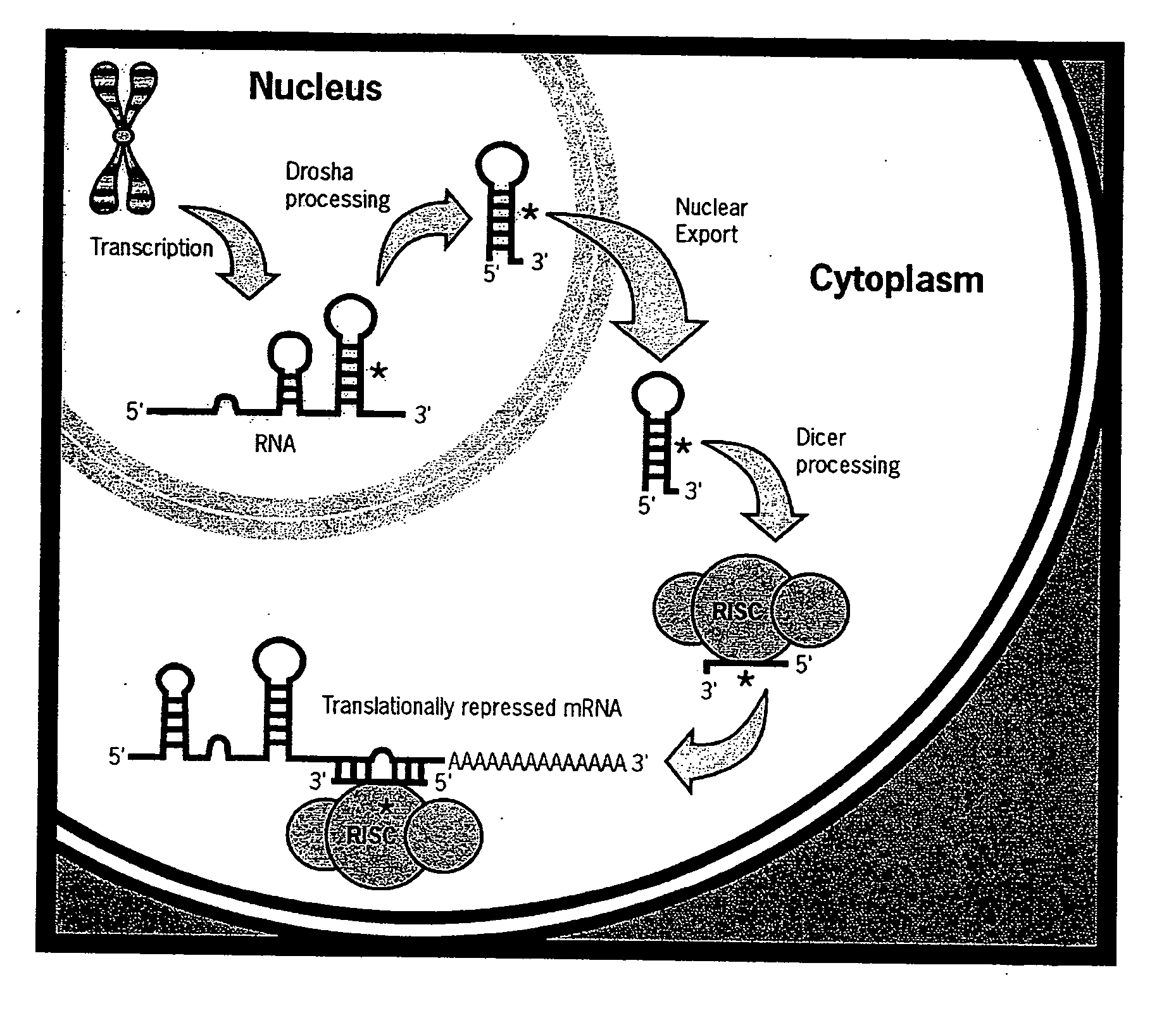Methods and Compositions Involving microRNA
a technology of microrna and composition, applied in the field of molecular biology, can solve the problems of limiting the sensitivity that can be achieved, no evidence, and 60-500mer probes typically used in microarrays were not compatible with mirna analysis, so as to avoid dye-quenching and improve tailing efficiency
- Summary
- Abstract
- Description
- Claims
- Application Information
AI Technical Summary
Benefits of technology
Problems solved by technology
Method used
Image
Examples
example 1
miRNA Isolation and Enrichment
[0253] miRNA was obtained from cell or tissue samples using a two-step process. In the first, all of the RNA in the sample is isolated away from the other contents of the sample. In the second step, the small RNAs that include miRNAs are preferentially extracted from the sample to create an RNA fraction that is significantly enriched for miRNAs.
[0254] A. Total RNA Isolation
[0255] Although there are a variety of methods that can be used to recover all of the RNA in a sample, silica binding and RNA elution were used as described below:
[0256] For tissue samples, 1 ml of Lysis / Binding Solution [4 M Guanidinium Thiocyanate, 0.5% N Lauryl Sarcosine, 25 mM NaCitrate pH 7.2, 0.1 M 2-Mercaptoethanol] per 0.1 g of tissue was added. The samples were kept cold, and the tissue was thoroughly disrupted in Lysis / Binding Solution using a motorized rotor-stator homogenizer. For cell samples, 0.6 ml of Lysis / Binding Solution was added per 107 cells. The cells were ly...
example 2
Labeling miRNAs: Factors Affecting Reaction
[0279] A. Appending Various Nucleotides to the 3′ ends of miRNAs with E. coli Poly(A) Polymerase
[0280] PolyA tails of several hundred nucleotides were efficiently added to the 3′ ends of miRNAs using ATP and E. coli Poly(A) Polymerase. Other nucleotides could also serve as substrates for the enzyme, most notably UTP. Modified nucleotides like 5-(3-aminoallyl)-UTP, adenosine′5′-(1-thiotriphosphate), uridine′5′-(1-thiotriphosphate), 8-[(4-amino)butyl]-amino-ATP, and 8-[(6-amino)butyl]-amino-ATP were substrates for E. coli Poly(A) Polymerase, but the lengths of the 3′ tails were significantly shorter than those generated with ATP and UTP. When only modified nucleotides were in the Poly(A) Polymerase reaction, the tails were typically 3-10 nucleotides long.
[0281] Various mixtures of standard and modified NTP (ATP or UTP) were tested for their capacity to be incorporated by polyA polymerase. The length of the tail could be extended tremendous...
example 3
Labeling miRNAs: Two-Step Fluorescent miRNA Labeling
[0288] 1. PolyA Polymerase Reaction
[0289] Isolated miRNA was resuspended in 4.0 μL H2O. The following were added to the miRNA sample: 10 μL 2× Poly(A) Polymerase (PAP) Buffer (20% Polyethylene glycol (MW 3,350), 20 mM MgCl2, 500 mM NaCl, 100 mM MES pH 6.5, 2 mM DTT); 2.0 μL 25 mM MnCl2; 2.0 μL NTP mix (1 mM UTP, 5 mM aminoallyl-UTP); 2.0 μL PAP (2 U / μL) (Cat# 2030G). The reaction mixture was incubated at 37° C. for 2 hours.
[0290] To begin the process of obtaining the tailed miRNA from the mixture, 10 μg of sheared yeast RNA and 80 μL of miRNA binding buffer (0.6 M NaCl, 70% EtOH) were added to the reaction mix and incubated at RT for 5 minutes. The mix was subsequently applied to a glass fiber filter column, which was then spun at 5000 rpm for 1 min. 300 μL of miRNA Wash Buffer (0.5 M NaCl, 55% EtOH) was added, and the column spun again at 5000 rpm for 1 min. The Wash / spin step was repeated before the column was spun again at 10...
PUM
| Property | Measurement | Unit |
|---|---|---|
| temperatures | aaaaa | aaaaa |
| temperatures | aaaaa | aaaaa |
| temperatures | aaaaa | aaaaa |
Abstract
Description
Claims
Application Information
 Login to View More
Login to View More - R&D
- Intellectual Property
- Life Sciences
- Materials
- Tech Scout
- Unparalleled Data Quality
- Higher Quality Content
- 60% Fewer Hallucinations
Browse by: Latest US Patents, China's latest patents, Technical Efficacy Thesaurus, Application Domain, Technology Topic, Popular Technical Reports.
© 2025 PatSnap. All rights reserved.Legal|Privacy policy|Modern Slavery Act Transparency Statement|Sitemap|About US| Contact US: help@patsnap.com



